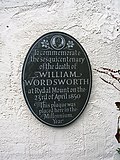Typography



Typography is the practical art of arranging how the printed word appears on the page.[1] Typography was born when print was born.[2][3] Early types were based on the letterforms of scribes, and the letters cut into Trajan's Column ("monumental inscriptions").[4] Later, gradually, type designs were based on the special needs of books, pamphlets, newspapers and advertisements.[5]
Typography ![]() pronunciation (info • help) includes not only letters, but all the set of symbols in a font, and it includes the overall design of a page or document.[6] It applies to any medium which may be read; therefore it includes text on computer screens. A typographer may design type, select fonts, and design the layout of pages and books. The term does not cover the act of printing itself, though many of the early printers were themselves typographers.[3]
pronunciation (info • help) includes not only letters, but all the set of symbols in a font, and it includes the overall design of a page or document.[6] It applies to any medium which may be read; therefore it includes text on computer screens. A typographer may design type, select fonts, and design the layout of pages and books. The term does not cover the act of printing itself, though many of the early printers were themselves typographers.[3]
Typography in the 20th century was greatly influenced by three things:
- Modernism and the modern art movement.[1][7]
- Information about the effectiveness of typography and design. Some of this comes from formal 'scientific' experiments,[8][9] but most comes from commercial sources.[10] Naturally, sales results before and after a book or magazine redesign are compared. A redesign of the typography on the jacket of a book (Roget's Thesaurus) "nearly doubled the sales".[11] Typographers themselves carry out mini-experiments to test alternatives.[12] This is an extension of scientific method to what is, at heart, an artistic process.
- The development of modern computer technology, which affected type design, and changed printing methods.[13]
A traditional aim of the typographer would be to produce a page which is, above all, legible and attractive to read, without its being obtrusive. For display typography, such as advertising, the display must be noticed before it is read. This had led to the development of many display typefaces which are highly visible, and which are available in large sizes.[13][14]
Typography Media
A specimen sheet of the Trajan typeface, which is based on the letter forms of capitalis monumentalis or Roman square capitals used for the inscription at the base of Trajan's Column, from which the typeface takes its name
Movable type being assembled on a composing stick using pieces that are stored in the type case shown below it
A revolving type case for wooden type in China, an illustration shown in a book published in 1313 by Wang Zhen
A specimen sheet by William Caslon shows printed examples of Roman typefaces.
Text typeset example in Iowan old style roman, italics, and small caps, optimized at approximately ten words per line, typeface sized at 14 points on 1.4 × leading, with 0.2 points extra tracking using an extract of a lecture by Oscar Wilde The English Renaissance of Art, 1882
Text typeset using LaTeX typesetting software, often used for academic papers and journals
Nineteenth century wanted poster for John Wilkes Booth (the assassin of U.S. President Abraham Lincoln) printed with lead and woodcut type, and incorporating photography
Plaque for the William Wordsworth Sesquicentenary, Rydal Mount, Cumbria, by John Shaw
Related pages
References
- ↑ 1.0 1.1 Tschichold, Jan 1991. The form of the book: essays on the morality of good design. Hartley & Marks, Vancouver. ISBN 978-0-88179-034-4.
- ↑ Lefebre L. & Martin H-J. 1990. The coming of the book. new ed, London.
- ↑ 3.0 3.1 Chappell W. & Bringhurst R. A short history of the printed word. Hartley & Marks, Vancouver. ISBN 978-0-88179-154-9
- ↑ Morison, Stanley. 1926 Type designs of the past and present. Fleuron, London.
- ↑ Twyman, Michael 1970. Printing 1770–1970. London: Eyre & Spottiswoode, Chapter 3 Types and other letterforms.
- ↑ Tracy, Walter 1986. Letters of credit: a view of type design. Gordon Fraser, London. ISBN 0-86092-085-2
- ↑ Spencer, Herbert. 1969. Pioneers of modern typography. Lund Humphries, London. Revised edition by Rick Poynor MIT Press 2004. ISBN 978-0-262-69303-5
- ↑ Tinker M.A. 1963 The legibility of print. Iowa State University Press: Ames, Iowa.
- ↑ Cornog D.Y. & F.C. Rose 1967. Legibility of alphanumeric characters and other symbols: II. A reference handbook. Washington D.C. National Bureau of Standards.
- ↑ Journals on advertising research contain hundreds of examples.
- ↑ Tedesco A.P. 1948. The relationship between type and illustration in books and book jackets. George McKibbin, New York. p31
- ↑ Spencer, Herbert 1952. Design for business printing. Sylvan Press, London. p88
- ↑ 13.0 13.1 Gottschall, Edward M. 1989. Typographic communications today. MIT Press, Cambridge, Mass. and London. ISBN 0-262-07114-2
- ↑ Bringhurst, Robert 2002. The elements of typographic style (version 2.5). Hartley & Marks, Vancouver. ISBN 0-88179-133-4








